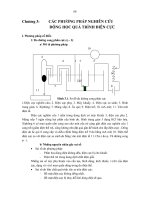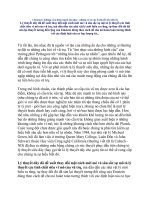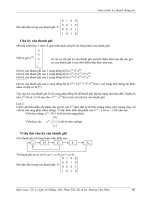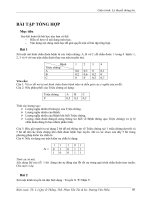ENGLISH SOUNDS LY THUYET
Bạn đang xem bản rút gọn của tài liệu. Xem và tải ngay bản đầy đủ của tài liệu tại đây (46.37 KB, 3 trang )
UNIT 1: ENGLISH SOUNDS
Numbers of sounds
I. Vowels: 12 pure vowels + 8 dipthongs
II. Consonants: 9 voiceless consonants + 15 voiced consonants
Pronunciation of the sounds.
A. Vowels:
I. Pure vowels:
a. Long pure vowels:
1. / ɑ: /: Open, Open your mouth wide. Your tongue should rest in the bottom of your mouth.
E.x. Far – hard – sharp – large, car, start, star, garden, father, tomato
2. / ɔ: /: Half-open, Put the front of your tongue down. Round your lips.
E.x. Ball, Tall, Four, Door, Short, Water, Daughter, Before
3. / u: /: Narrow, Make a lip into a circle. Put your tongue up and back.
E.x: Move, Food, Too, Soon, Blue,
4. / ɜ: /: Half-open, Your mouth and tongue should be relaxed. Lưỡi cong lên chạm vào vòm
miệng khi kết thúc âm.
E.x. Girl- burn- turn- world, Bird, First, Work, Thirty,
5. / i: /: Narrow with big smile. You will never be sad when pronounce this
sound. Your tongue touches the sides of your teeth .
E.x. Tea – Read – Feel – Keep, Sheep, Eat, Key, Bee, Teacher
b. Short pure vowels:
1. /ɪ/: Narrow, Make your mouth a bit less wide than for /i:/. Your tongue is a bit further back in
your mouth than for /i:/. Lower your tongue.
Ill – it – give – miss, Fish, Him, Chicken, Dinner, Six
2. /ʌ/: Open, Open your mouth wide. Your tongue should rest in the middle of your mouth.
E.x. Love – mother- cut- flood, Nothing, Money, Dove
3. /ɒ/: Open, To make this sound, round your lips a little.The front of your tongue is low and
towards the back of your mouth.
E.x. Hot, Dog, Box, Fox, Frog
4. /ʊ/: Narrow, Make your lip a little rounded. Gần giống “ư” trong tiếng Việt nhưng không
dùng môi để phát âm mà đẩy hơi rất ngắn từ cổ họng. Lưỡi hạ thấp.Your tongue is not so far
back as for /u: /.
E.x. Look – good – put, Cook, Foot, Book
5. /ə/: Half-open, Open your mouth very slightly and simply. The lips and tongue are relaxed.
E.x. Banana, Zebra, Sofa, Woman, Doctor, Flower
6. /e/: Half-open, is a short and relaxed sound. Open your mouth wide, đầu lưỡi chạm vào phần
lợi trước của hàm dưới, miệng mở tự nhiên và thư giãn
E.x. Bed – get – let – red, Head, Many, Egg
7. /æ/: Open, Open your mouth wide, đầu lưỡi chạm vào phần lợi trước của hàm dưới, miệng
mở rộng và căng ra.
E.x. Bad, land, happy, Cat, Hat, Bag, Black, Hand, Map, Sad, Black
II. Dipthongs:
1. /eɪ/:
2. /aɪ/
3. /ɔɪ/
4. /ɪə/
5. /eə/
6. /ʊə/
7. /əʊ/
8. /aʊ/
may – take – name – save
my – life – find – time
toy – noise – point – boil
hear- dear- beer- near
bear- care – fair- share
poor- sure
show – home – road – told
now- shout- house- cow
B. Consonants
I. Voiceless consonants: your vocal chords do not vibrate when you make this sound.
1. / f /: the air is stopped by pushing the bottom lip and top teeth together. The air is then pushed
through to create the sound. Do not curl your lip too far under your top teeth to make this
sound. This is a common error many language students make. This makes it difficult to connect
the F sound to other sounds in a word.
2. /p/: produced in the front of the mouth.
3. /k/: The back part of your tongue should touch the roof of your mouth in the back to briefly
stop the air.
4. /t/: your tongue stops the flow of air at the front of your mouth. In both of these sounds, the
tip of your tongue presses against the back of your top teeth. The sides of your tongue will also
press against the upper side teeth to stop the flow of air.
5. /s/: Both of these sounds are produced in the front part of your mouth. When you make these
sounds, your lips will be slightly open. Your teeth should lightly touch in the front or be very
close together. The front of your tongue will touch the back of your lower teeth. The back of
your tongue touches the roof of your mouth on the sides. The S sound is a hissing sound like a
snake.
6. /h/: The H sound makes little sound. It is a very quiet sound. It is made by passing air
through your mouth. A common error of English students is to overproduce this sound.
7. /ʃ/: To make the SH and ZH sounds, you pull in the sides of your mouth so your lips pucker.
Your lips are shaped like a loose, open kiss. It is like the shhhh sound we use when we want
someone to be quiet.
8. /tʃ/: The tip of the your tongue presses against the back of your top teeth to stop air from
leaving your mouth. The sides of your tongue press against the sides of your upper teeth.
9. /θ/: place the tip of your tongue between your top and bottom teeth. It should not stick out
very far. Then blow air through the space between your tongue and your top teeth. You also
blow air through the top teeth – (Thin /θɪn/, Thirsty /ˈθɜːrsti/, Mouth /maʊθ/]
II. Voiced consonants: That means that the vocal cords vibrate to make the sound.
1. /b/: produced in the front of the mouth
2. /d/: your tongue stops the flow of air at the front of your mouth. In both of these sounds, the
tip of your tongue presses against the back of your top teeth. The sides of your tongue will also
press against the upper side teeth to stop the flow of air.
3. /g/: The back part of your tongue should touch the roof of your mouth in the back to briefly
stop the air.
4. /j/: the middle part of your tongue comes forward and presses against the roof of your mouth
near the top tooth ridge. The tip of the tongue will lightly touch your bottom teeth. Your jaw
will be almost closed when you make this sound. Your lips will be loose.
5. /ŋ/: nasal, Your tongue is raised and further back in your mouth – running, sing
6. /l/: nasal. When you make the light L sound, the tip of your tongue will rise up and press
against the back of your top teeth.
7. /m/: nasal, is made by lightly pressing your lips together while making the sound with your
vocal chords.
8. /n/: is made by moving air through the nasal passage. Your lips will be slightly parted. The
tongue touches the roof your mouth just behind your teeth. You should feel a vibration in your
nose.
9. /r/: Raise the back of your tongue to lightly touch the back teeth on both sides of your mouth.
The center part of the back of your tongue should be lower to allow air to move over it. The tip
of your tongue may curve a little, but it will not touch your mouth or lips. Your tongue will be
tense. It will not be loose. The position of your lips is in a tight O shape.
10. /v/: the air is stopped by pushing the bottom lip and top teeth together. The air is then
pushed through to create the sound. Do not curl your lip too far under your top teeth to make
this sound. This is a common error many language students make. This makes it difficult to
connect the V sound to other sounds in a word.
11. /w/: To correctly pronounce the W sound, form your lips into a small, tight circle. It is
important to hold your lips correctly. Imagine whistling or blowing out a candle.
12. /z/: Both of these sounds are produced in the front part of your mouth. When you make
these sounds, your lips will be slightly open. Your teeth should lightly touch in the front or be
very close together. The front of your tongue will touch the back of your lower teeth. The back
of your tongue touches the roof of your mouth on the sides. The Z sound is like the sound of
buzzing bees.
13. /dʒ/: The tip of the your tongue presses against the back of your top teeth to stop air from
leaving your mouth. The sides of your tongue press against the sides of your upper teeth.
14. /ʒ/: To make the SH and ZH sounds, you pull in the sides of your mouth so your lips
pucker. Your lips are shaped like a loose, open kiss. It is like the shhhh sound we use when we
want someone to be quiet.
15. /ð/: place the tip of your tongue between your top and bottom teeth. It should not stick out
very far. Then blow air through the space between your tongue and your top teeth. You also
blow air through the top teeth.






